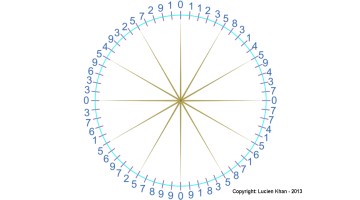The last digit of the numbers in the Fibonacci Sequence form a pattern that repeats after every 60th number:
0, 1, 1, 2, 3, 5, 8, 3, 1, 4, 5, 9, 4, 3, 7, 0, 7, 7, 4, 1, 5, 6, 1, 7, 8, 5, 3, 8, 1, 9, 0, 9, 9, 8, 7, 5, 2, 7, 9, 6, 5, 1, 6, 7, 3, 0, 3, 3, 6, 9, 5, 4, 9, 3, 2, 5, 7, 2, 9, 1
This pattern can be seen in the following list of the first 72 Fibonacci numbers:
| 0 | 0 |
| 1 | 1 |
| 2 | 1 |
| 3 | 2 |
| 4 | 3 |
| 5 | 5 |
| 6 | 8 |
| 7 | 13 |
| 8 | 21 |
| 9 | 34 |
| 10 | 55 |
| 11 | 89 |
| 12 | 144 |
| 13 | 233 |
| 14 | 377 |
| 15 | 610 |
| 16 | 987 |
| 17 | 1,597 |
| 18 | 2,584 |
| 19 | 4,181 |
| 20 | 6,765 |
| 21 | 10,946 |
| 22 | 17,711 |
| 23 | 28,657 |
| 24 | 46,368 |
| 25 | 75,025 |
| 26 | 121,393 |
| 27 | 196,418 |
| 28 | 317,811 |
| 29 | 514,229 |
| 30 | 832,040 |
| 31 | 1,346,269 |
| 32 | 2,178,309 |
| 33 | 3,524,578 |
| 34 | 5,702,887 |
| 35 | 9,227,465 |
| 36 | 14,930,352 |
| 37 | 24,157,817 |
| 38 | 39,088,169 |
| 39 | 63,245,986 |
| 40 | 102,334,155 |
| 41 | 165,580,141 |
| 42 | 267,914,296 |
| 43 | 433,494,437 |
| 44 | 701,408,733 |
| 45 | 1,134,903,170 |
| 46 | 1,836,311,903 |
| 47 | 2,971,215,073 |
| 48 | 4,807,526,976 |
| 49 | 7,778,742,049 |
| 50 | 12,586,269,025 |
| 51 | 20,365,011,074 |
| 52 | 32,951,280,099 |
| 53 | 53,316,291,173 |
| 54 | 86,267,571,272 |
| 55 | 139,583,862,445 |
| 56 | 225,851,433,717 |
| 57 | 365,435,296,162 |
| 58 | 591,286,729,879 |
| 59 | 956,722,026,041 |
| 60 | 1,548,008,755,920 |
| 61 | 2,504,730,781,961 |
| 62 | 4,052,739,537,881 |
| 63 | 6,557,470,319,842 |
| 64 | 10,610,209,857,723 |
| 65 | 17,167,680,177,565 |
| 66 | 27,777,890,035,288 |
| 67 | 44,945,570,212,853 |
| 68 | 72,723,460,248,141 |
| 69 | 117,669,030,460,994 |
| 70 | 190,392,490,709,135 |
| 71 | 308,061,521,170,129 |
| 72 | 498,454,011,879,264 |
Lucien Khan arranged these 60 digits of the pattern in a circle, as shown in illustration below:
Here he found other interesting results:
- The zeros align with the 4 cardinal points on a compass.
- The fives align with the 8 other points of the 12 points on a clock.
- Except for the zeros, the number directly opposite each number adds to 10.
Lucien postulates that ancient knowledge of these relationships contributed to the development of our modern use of 60 minutes in an hour, and presentation of numbers on the face of the clock.
I found too that any group of four numbers that are 90 degrees from each other (15 away from each other in the circle) sum to 20, except again for the zeros. As an example, use 1, 7, 9 and 3, which appear one to the right of each of the compass points.
Additionally, every group of five numbers that define the points of the 12 pentagons on the circle also create a pattern. Four of the pentagons have even-numbered last digits of 0, 2, 4, 6, and 8. The remaining eight pentagons have odd-numbered last digits of 1, 3, 5, 7 and 9.
Another interesting pattern yet was observed by Lucien Khan: The 216th number is this sequence is 619220451666590135228675387863297874269396512. The sum of all the digits in that number add up to 216, as well. He notes that it is believed that the secret or hidden name of God contains 216 characters. There are many other fascinating relationships and sacred geometries, which are presented by Lucien Khan in more detail at the links below.
References:
https://docs.google.com/document/d/1mVWd1aLiYZQU8VvYFBnW8kxodeYim3bYDIFfh-w42eU/pub
https://www.youtube.com/watch?v=bY5zwXXoUHc
